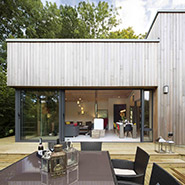Engineered Flooring & Under Floor Heating
Engineered flooring & Under floor heating
Engineered flooring on top of subfloor heating
A wooden floor above subfloor heating. Is that even possible? – Yes, it is.
But for this to work the indoor temperature must vary only gradually and to a limited extent to prevent the wood from shrinking or expanding.
A subfloor heating system is a ‘slow’ system: it takes longer for a room to reach the right temperature and also for the heat to leave the room again. The heating pattern of the occupants is very important:
the more stable this is, the better.
Too much heat causes the wood to dry out and shrink. Rapid and major fluctuations in the temperature may damage the floor. Practical matters also play a role: rugs and carpets on the floor and cupboards with no space underneath can also cause heat to build up, possibly resulting in shrinkage joints and cracks. These can be prevented with the help of one or two tips on heating and interior design.
Application of Engineered flooring
Multiplank consists of a top layer of solid wood, 5.5mm thick, which is glued onto a 14.5mm underlayment at the factory. In the following wood species, both types of floor can be used in combination with floor heating either as the main source of heat or as additional heating:
• Afrormosia
• Afzelia Doussié
• American Oak
• AmericanWalnut
• European Oak
• Iroko
• Merbau
• Teak
The instructions you will need to follow are provided below.
NOTE: You must be very careful about making sure you adhere to the requirements imposed in terms of the climatic conditions. If the humidity in the room does not achieve the values stipulated, the chances of cracks forming in the top layer will increase significantly. Cracking as a consequence of this is not covered by any guarantee.
Installation method
The boards can be glued directly onto the cement screed. Make sure that the cement screed is form retaining and level. We recommend at least D20 cement. The flatness can be checked: the maximum height difference over 2 metres is 2 mm.
If you opt to glue the floor directly onto the cement screed (Option 1), we recommend that you take the following steps:
• Apply a primer and, if necessary, a liquid moisture barrier as well.
• Use a good quality wood flooring specific adhesive such as Sika, Lecol or Taylor.
• You should glue the boards on top within 24 hours with the help of a toothed T69 steel adhesive comb.
• Make sure that pressure is applied to the boards for 24 hours after being glued into place
using at least a 20kg weight per m².
Heating up before laying the wooden floor
• Before you use the subfloor heating unit for the first time, the sand/cement screed should be at least
42 days old. Set the temperature to 20 ºC on the first day of use, and then raise it by 5 ºC every day.
• Make sure that the supply water temperature does not exceed 45 ºC. Maintain this maximum temperature for at least 24 hours per centimetre of floor thickness.
• The lowering of the water temperature should also be in increments of 5 ºC every 24 hours until you reach a water temperature of 20 ºC.
• The entire heating process takes 14 days – ensure good ventilation during this period to allow moisture to escape. Check the cement screed for residual moisture after this process. This must not exceed 1.8% for a sand/cement screed and 0.3% for an anhydrite floor; if a liquid moisture barrier is used, the maximum is 3%.
Heating up after laying the wooden floor
• When laying the floor, the screed should be between 15 and 18 ºC. Maintain this temperature for at least 5 days after laying, then you can slowly raise the temperature (1 to 2 ºC every day) until you reach the temperature you desire or the maximum permissible temperature.
• The residual moisture in the floor must be no more than 1.8% for a cement screed and no more than 0.3% for an anhydrite floor.
• The maximum contact temperature of the cement screed is 28 ºC. The contact temperature is the temperature of the surface of the cement screed / anhydrite floor, measured 3 heating days after setting the temperature (depending on the depth of the pipes).
Heating during the season
• Raise the temperature very gradually at the start of the heating season, and lower it again very gradually at the end (1 to 2 ºC every day).
• To keep the floor as stable as possible, do not create any difference in day and night temperatures.
Key points
• The RH in the room must be between 40% and 65%. Measure the RH using a well-calibrated measuring device in a non- draughty room 10cm above the floor. NOTE: if the RH is too low, cracks may form.
• The cover on water pipes must be at least 30 mm thick to ensure a good distribution of heat.
• The maximum contact temperature of the cement screed is 28 ºC.
• Heat the room at a steady temperature.
• Follow the heating protocol before, during and after installation.
• When you begin to turn up the subfloor heating again in winter, do so gradually (raise the temperature approximately 1 to 2 ºC every day).
• Sand an anhydrite floor beforehand with K24, remove all dust and always apply a primer.
• If there is a chance of rising moisture, or residual moisture exceeding 1.8% (for an anhydrite floor no more than 0.3%) with a maximum of 3%, then apply 2 x PU280 crosswise to act as a moisture barrier.
• Use a good adhesive – ask your supplier for advice.
• Apply the adhesive using a toothed T69 steel adhesive comb.
• Do not place any rugs on top, or cupboards with no space underneath.
• Cracks and shrinkage joints are often caused by insufficient RH and/or an excessively high water temperature.
Guarantee
Click to view Heywood warranty documentation
We guarantee a stable product and also give a guarantee against delamination, excessive deformation and cracking. Humidity monitoring sensors should be installed in various locations of the floor. We may reject claims where these sensors have not been used.
Installation should be carried out in accordance with the above instructions.
The climate should satisfy the above requirements (RH between 40% and 65% measured 10 cm above the floor using a calibrated hygrometer; the contact temperature of the cement screed must be no higher than 28 ºC).
Cracking that does not exceed the quality description by more than 10% is not covered by the guarantee.




